IDEX Online Research: Third Quarter U.S. Jewelry Sales Show Improvement
December 17, 09 by Ken Gassman
Total U.S. jewelry sales were nearly flat in the third quarter versus the same period a year ago. This was a dramatic improved from the first two quarters of 2009, when jewelry sales were down 5-6 percent from a year ago. Third quarter jewelry sales for specialty jewelers in the U.S. market showed only a moderate single-digit decline, in contrast to earlier quarters in 2009 when sales were down in the mostly double-digit range.
· Total jewelry sales were flat for the fiscal third quarter (August, September, October) of 2009 versus the same period a year ago. Total jewelry sales were down 3.0 percent in the third calendar quarter. Sales trends in the third quarter for total jewelry sales – by all retailers including specialty jewelers, discounters, and other multi-line retailers – are shown on the graph below. It is clear that sales trends improved significantly in the third quarter versus earlier quarterly periods in 2009.
| 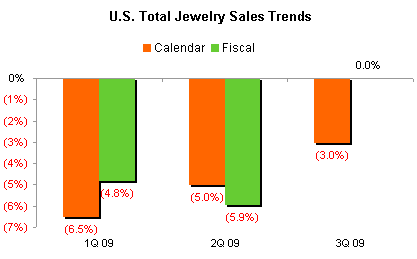
Source: US Dept of Commerce
|
· Specialty jewelers also posted improved sales trends in the third quarter. On a fiscal basis (August, September, October), specialty jewelers’ sales were down 4.1 percent from a year ago. On a calendar basis, third quarter sales for specialty jewelers dropped by 7.9 percent. The graph below illustrates quarterly sales trends for specialty jewelers during 2009. Each quarter has shown progressive improvement.
| 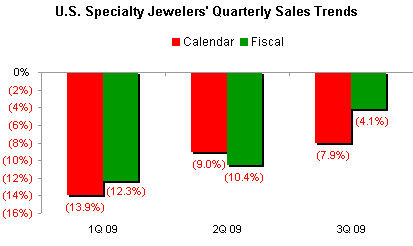
Source: US Dept of Commerce
|
· Specialty jewelers lost market share in the third quarter. In prior recessions, specialty jewelers also lost market share to multi-line retailers. Unfortunately, specialty jewelers never seem to regain this lost market share. In the early 1970s, specialty jewelers sold about 72 percent of all jewelry in the U.S. (by value); this dropped to around 48 percent last year, and will fall further this year. The graph below illustrates the difference in sales trend for total jewelry sales versus jewelry sales for specialty jewelers for the third calendar quarter; results for the fiscal quarter (August, September, and October) reflected the same trends.
| 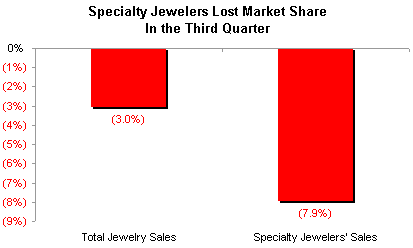
Source: US Dept of Commerce
|
Monthly Sales Show Improvement Within the Quarter
Jewelry sales in the U.S. market during each month of the third quarter showed improvement, when compared with the same month a year ago. Total jewelry sales were up over the prior year in both September and October.
For specialty jewelers, monthly sales trends were slightly less robust. While specialty jewelers posted a sales gain of 0.3 percent for September (flat, for all practical purposes), sales declined by 0.6 percent in October (again, roughly flat). Both of these numbers are preliminary; our conclusion is that sales were about flat. While these levels are below total industry sales trends, they are a notable improvement over prior monthly periods, when sales dipped by significant double-digit levels.
U.S. retail sales (ex-auto and food) also showed improvement each month during the third quarter of 2009. While retail sales comparisons have not yet turned positive, they are headed toward positive territory and will likely get there by the end of the year.
The graph below summarizes monthly sales trends in both the calendar and fiscal third quarter for total U.S. jewelry sales as well as total U.S. retail sales (ex-autos and food).
| 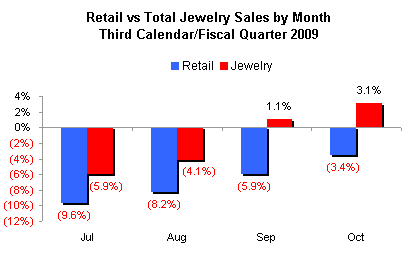
Source: US Dept of Commerce
|
Factors Driving Sales
The U.S. economy is in a recovery mode, and retail sales – along with jewelry sales – are also showing improvement. Consumer spending is particularly important in the U.S., since it comprises almost 70 percent of Gross Domestic Product (GDP). When consumers cut back their spending, the economy contracts. This is in stark contrast to many nations around the world, where government spending represents up to 50 percent of total expenditures. These nations – mostly socialist – may be driven by government spending, but in a recession tax revenues dry up and those governments must print more money to keep the economy going. When they print money without production increases, inflation flares.
The following are some factors which have caused U.S. consumers to loosen their purse strings and return to the malls this Fall:
· Real GDP posted a 2.4 percent gain in the third quarter of 2009. This is the first gain since the U.S. economy became mired in a recession in early 2008. This signaled to consumers that the recession is essentially over, and it is okay to start spending again.
· Consumer wealth levels have begun to rise. The stock market has recovered from its dismal lows in March; consumers’ portfolios are now showing positive performance. Home values appear to have bottomed, and markets have begun to show signs of life in many metros.
· U.S. consumers are tired of the recession. Negative media reports had a depressing impact on spending late last year and early in 2009. Consumers cut back more than necessary – they had the money to spend, but reports of the oncoming “end of the world” hurt expenditures. Now that it is clear that the economy will recover, consumers have returned to the malls. Americans view shopping as a recreational habit.
· Merchants are offering substantial discounts to entice shoppers into their stores. Shoppers can “smell” a bargain, and some merchants are offering tempting retail prices.
· The consumer savings rate has ticked down, after rising during the depths of the recession. This is another sign that American consumers are now less worried about their future earning power.
Jewelers’ Results for Third Quarter Mix
A majority of the publicly held specialty jewelers in the U.S. market lost market share. Those losing share of market were mostly the high-end merchants who have suffered substantially in the current recession. Jewelers who offered the perception of value seemed to have fared better. Movado’s Outlet Stores, along with Sterling (Kay Jewelers) and Blue Nile (online) gained market share in the third quarter.
The graph below illustrates third quarter total sales trends for U.S. publicly held jewelers.
| 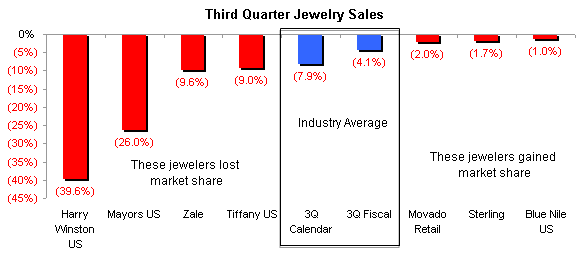
Source: Company reports & US Dept of Commerce
|
Publicly Held Jewelers Talk About Their Sales Trends
The following are managements’ comments about third quarter sales trends by company.
Blue Nile – Total sales up 2.4 percent; U.S. sales down 1.0 percent; average ticket down 1.7 percent; total orders up about 4 percent – Management is expecting fourth quarter sales – driven by holiday demand – to be the strongest three-month period of the year. Demand for diamond engagement rings and wedding bands remains solid, with both year-to-year sales dollars and unit volume up. The company continues to spend about 4 percent of revenues on marketing.
Sterling Jewelers – Total U.S. sales down 1.7 percent; U.S. same-store sales down 2.4 percent; average selling price down 3.2 percent in the mall brands and down 7.7 percent at Jared (excluding the impact of low-ticket charm bracelets); number of transactions in mall brands up 7 percent; number of transactions in Jared about flat. Same-store sales were marginally positive in the mall brands, and the sales decline at Jared slowed. The company continues to differentiate itself through exclusive merchandise. Television advertising impressions during the holiday selling period will be higher than originally planned, and will be marginally up for Jared and down mid-single digit for Kay versus last year. Credit participation is up about 70 basis points for the year-to-date, indicating that Sterling appears to be using its in-house credit operation to “buy” sales. The approval rate for credit sales is up 160 basis points, but it is still below the level of two years ago, indicating that Sterling is still somewhat selective about to whom it extends credit. Net bad debt is about 6 percent of sales (or about 12 percent of credit sales), up from its historical range of 4-5 percent. The average amount of a credit sale can be up to triple the amount of a cash sale, so it pays Sterling to extend credit to help build sales volume. While rising gold prices have hurt the company’s margin on gold jewelry sales, declining polished diamond prices should help boost margins.
Movado Retail – Total retail sales down about 2 percent. Outlet sales were about flat, while sales in the Movado Boutiques were down by an undisclosed amount which we estimate to be in the mid-single digit range. These trends confirm that consumers are seeking value-priced goods. In Movado’s wholesale watch division, U.S. sales were up 1.6 percent in the quarter, while international wholesale sales fell by 13.2 percent.
Tiffany & Company – Total U.S. retail sales were down 9 percent; U.S. same-store sales fell by 10 percent; U.S. e-commerce and catalog sales fell by 9 percent. Sales declines diminished later in the quarter: August sales were down 18 percent; September sales were down 7 percent; and October sales declined by 5 percent. Total sales were hurt by both lower average tickets and fewer transactions. However, we believe the conversion rate (browsers-to-buyers) was up modestly in the quarter. Store traffic remains below year-ago levels. Sales in the New York flagship store fell by 8 percent, and same-store sales in the nine branch stores in the New York area were down 9 percent. Branch same-store sales fell by 11 percent. In short, the sales decline was broad-based, with no market meaningfully divergent from the average. Jewelry at “accessible” price points – lower ticket items – sold better than higher-ticket goods. The company’s new White Plains (NY) store includes a new selling concept – approachable merchandise where customers are encouraged to try on jewelry while being advised by a jewelry stylist. E-commerce and catalog sales fell due to fewer orders and a lower average ticket. Worldwide, the company has experienced a “good” increase in engagement jewelry sales. However, high-end statement jewelry sales have continued to decline. The company expects that fourth quarter global sales will be positive; total sales for the year are likely to be down by only 8 percent versus a prior forecast of a 10 percent decline.
Zale – Total sales were down 9.6 percent; same-store sales fell by 6.8 percent; e-commerce orders and sales were up 17 percent. Sales improved each month of the quarter ended October. The number of transactions was up slightly, but the average ticket fell marginally. The company is focusing on exclusive merchandise with accessible price points; management estimates that about 25 percent of its merchandise is exclusive. Pre-packaged gifts can be purchased from $39 to $199. The company has added several lines of fashion watches with price points between $65 and $795. It has also introduced De Beers’ Everlon Collection with over 30 items priced between $199 and $2,499. Zale plans to increase its multi-channel marketing impressions in the fourth quarter: online impressions will be up six-fold. The company’s e-commerce business should hit $70 million for the full fiscal year ended July 2010, up 20 percent from the prior year.
Mayors – Same-store sales in U.S. stores fell by 26 percent for the six months ended September (the company reports results on a six-month basis as a foreign issuer). Customer traffic was down, and the average ticket fell during the period. Same-store sales in the Canadian division were down 10 percent, while total corporate same-store sales were down 19 percent.
Harry Winston Diamonds – U.S. total sales were down just under 40 percent in the quarter ended October (sales in Asia were up 53 percent and European sales were down 10 percent). The number of stores was flat at 19 units. Harry Winston management called attention to its website which allows customers to make shopping appointments at its stores. The company has recently introduced a number of new products at more modest price points which have generated increased unit and dollar sales with improved margins. The company, under its new retail president who came from Cartier, plans to focus more on the bridal business. Virtually no new stores are planned over the next two years, other than perhaps a unit or two in China, which may be operated by a third party. No stores are slated for closing at this time, despite some question about the long term viability of some of the recently opened units. Globally, Harry Winston noted that the Russians have “returned” to the market and are helping to boost retail sales. In addition, there has been a pick-up in sales to Middle Eastern customers. Business in Taiwan has also been “good”, according to management.





